All email marketers will to have at least once decide whether to use a single opt-in or double opt-in for their email lists. A single opt-in means that once a visitor enters their email address into your subscription form and clicks the sign up button they are automatically on your list.
A double opt-in means that not only does the visitor have to enter their email and click sign up, they also have to confirm their subscription via a link which send to them in a confirmation email. This is why many people say that the term double opt-in is incorrect, we should be using the term confirmed opt-in instead. Technically, the term confirmed opt-in is more correct however I will use the term double opt-in in this article as it is more commonly used (even by email marketing companies).
Improved Stats for Double Opt-In Email Lists
Many people suggest the issue of single vs double opt in as an issue of building a large list versus building a quality list. In many ways, this is true. Matthew Grove from MailChimp published an article in September 2011 which highlighted Double Opt-in vs. Single Opt-in Stats. In the article he shows the stats from taking a sample of 30,000 users who’ve sent at least 10 campaigns. The lists range from only 500 subscribers to a whopping 1.5 million.
I encourage you to read his article in full but for quick reference I have published the results below. Across the board, stats were much better for email lists that required users to opt in. This is no surprise as these lists contain people who took the time to confirm their email address.
Double opt-in lists had 72.2% more unique email opens and 75.6% more opens overall.
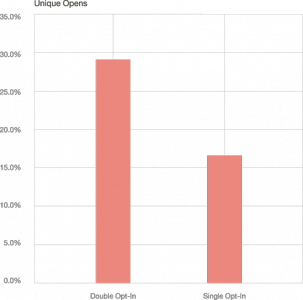
Double opt-in lists had 114% more clicks than single opt-ins. It goes to show how responsive double opt-in lists are when compared to single opt-in.
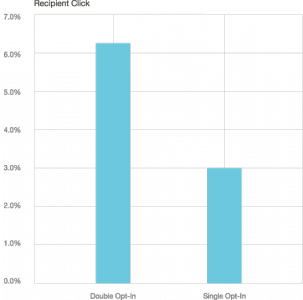
Bounces are when an email is rejected by the email server. A soft bounce may be a temporary issue but a hard bounce suggests that the email account no longer exists. Double opt-in lists had 48.3% less hard bounces and 25% less soft bounces.
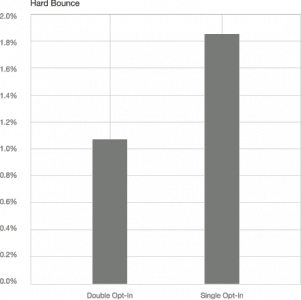
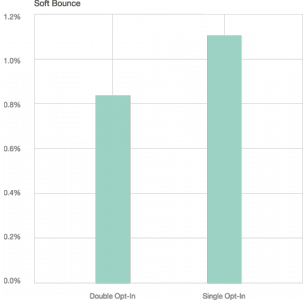
Double opt-in lists had 7% less unsubscribes too.
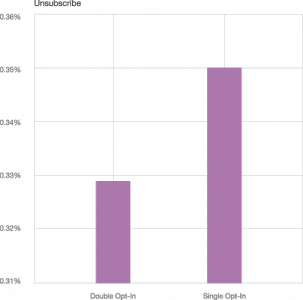
Remember, this study wasn’t a small sample. It was taken from 30,000 different email lists and some of those lists were in excess of millions. The study didn’t take into consideration the unique factors for each list such as niche, why people had signed up etc, however the stats are very convincing nevertheless.
What the study proved is that double opt-in lists are higher in quality, but we already knew that didn’t we?
Like for like, an email list of 1,000 subscribers who confirmed their email address via an email link will always be more responsive than a list which didn’t. We can’t really compare like for like as the list that didn’t ask for the user to confirm their email address will be larger. So to get a true figure you’d have to compare two lists within the same niche which have a different number of subscribers: a double opt-in list with 1,000 subscribers and a single opt-in list with say 1,500 subscribers.
Is Quality More Important Than Size?
The reason I started looking into this issue more was because of an email I received from marketer Clay Montgomery recently. I have always used double opt-in to ensure a higher quality however he touched a nerve in the email when he said:
Anytime you set up a new list in your Aweber account you should always turn off the Confirmed Opt-In option. Leaving that ON will mean all your optins will have to click on a link in their email to confirm and until they do, you can’t email them.
After years of testing that option both ON and OFF I can tell you that you will lose 50% of your optins if you make them Double Opt-In. It has had very little effect on the responsiveness of my lists with it turned OFF.
50% is a huge amount. I checked my stats afterwards and was relieved to see my own rate was lower. It was however still annoyingly high. 960 people had signed up to my list here however 156 had not confirmed their email. That means, that my email list was 14% smaller than it could have been than if I would have chosen single opt-in instead.
Email companies, quite rightly, don’t allow you to email people who didn’t opt in, so in effect these people are lost forever (some may return and sign up again). The question is whether these users are worth worrying about. If they didn’t confirm their email address, how serious can they be about viewing your emails?
I think it’s wrong to assume that someone who didn’t confirm their email didn’t want your emails. Confirmation emails frequently go to the spam folder so they may have been very interested in reading what you had to say but then forgot to check their spam folder. It’s also wrong to think that people who do confirm their email are always more valuable. I sent out an email earlier this week and 5 people unsubscribed; all of whom had signed up to my newsletter using double opt-in.
It’s obvious that collectively, people who have went through an additional step to sign up to your email list will be less likely to unsubscribe than those who don’t. However, it’s silly to assume that people who hadn’t confirmed their email will not respond to your emails, click your links or buy your products.
Let’s say that I had used single opt-in. Of those 156 people, how many would have unsubscribed when I sent an email? How many would have clicked on my links and perhaps came to this blog and left a comment? We’re never going to know the exact answer but I have no doubt that many of those people could have became avid readers of this blog.
As my blog grows, my list will grow too. And vice versa. If my blog traffic increases one month by 30%, it’s safe to assume that the number of people who subscribed to my newsletter through my blog would have increased by a similar amount.
It’s also true that as I grow my list, my blog traffic will increase, as I email my subscribers updates from this blog regularly. So in effect, a 20% loss of growth in my email list could represent a 20% loss of growth of my blog. At the very least my overall readership is lower than it could have been.
Email Marketing Truths & Myths
I wish I could tell you all whether single opt-in or double opt-in is better. The truth is, it’s an issue that divides everyone who is involved with email marketing. Some top experts promote single opt-in, others explain you should request people to confirm their emails to ensure quality.
Email marketing companies such as Aweber are pretty consistent in that they all advise you to use double opt-in. When you switch to single opt-in using Aweber, they will will post a message discouraging you as double opt-in prevents malicious subscriptions and false spam allegations.
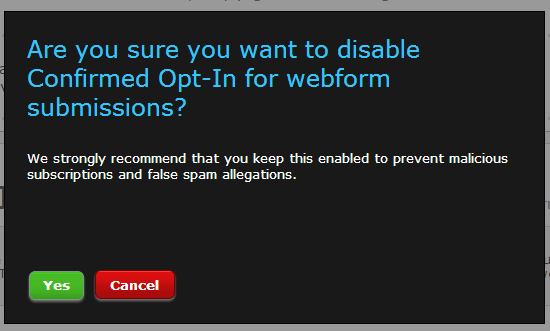
It isn’t clear whether single opt-in email lists do suffer from malicious subscriptions (e.g. someone else entering an email address somewhere for revenge) or spam allegations. At least not by a significant level. A lot of the the supposed cons of single opt-in are not backed up by hard facts, particularly in relation to increased reports of spam.
I started a discussion on the topic on Warrior Forum entitled “What’s Your View on Double Opt-Ins?”. A lot of experienced internet marketers responded to this thread and it was very divided. Many people strongly believe single opt-in is better whilst many others strongly believed the opposite. A few others, like me, are still unsure as to which, if any, is best.
There were so many great comments about whether single or double opt-in is best. Below is a collection of some of the best comments.As you will see, there are many arguments for and against using either method.
“I personally use single opt in and never had problems with spam complaints or poor open and click rates.
If someone is putting there email address in, then in my eyes they want to hear what I have to say or offer. They do not need to have another email to confirm what they already want.
My opinion of course” – Mike Gregory
“I tend always to use single opt-in for my general list building but there are exceptions. I use double opt-in for product activation key delivery, for example.
One tip that I got a couple of years back which I always apply – especially for single opt-in subscribers – is always put a reminder of when they signed up and why at the bottom of your e-mail. Use the tags to pull the info in.
Some say that by including this information in e-mails makes them less likely to go to spam folders but it will definitely minimise the possibility of complaints.” – Barry Rodgers
“It’s possible, using “confirmation”, to get the proportion of subscribers confirming their email addresses up to 85% or even 90%, but it isn’t always easy: you need to give them a lot of very clear information, both in words and with pictures, immediately after submitting their email addresses. I strongly prefer single opt-in, myself. For what it’s worth, I also find that many (not all) of the arguments commonly adduced in favour of using confirmed opt-in are based either on mistaken premises or on misattributed causation (in other words they don’t really make sense). Specifically, the ideas that people who’ve confirmed their email addresses at the time of their original opt-in are somehow more likely to open your emails and/or less likely to complain about spam in future, if you spam them, are complete Urban Myths of internet marketing.
I just wish – with hindsight – that I’d switched to single opt-in at an earlier stage of my IM career, instead of taking months to do so.” – Alexa Smith
“I used double optin when I started because I read about all the potential for spam complaints. Today I use single optin because I get more subscribers. I do put information on how they got on my list in the email. I do send the freebie they get by optin to the email address to avoid fake email address by just giving it to them after entering an email address.” – Jennifer Minge
“I always double opt in except when I’m hosting a giveaway event. I want leads, not clicks on my list (except for a giveaway event where my entire job is to send enough clicks to participants).
You are completely right, your opt in will jump incredibly by turning your list to single opt in… but who cares. You’re not going for the biggest list in the world… you’re going for the most responsive list.
To get a responsive list, you need to build a group of people who want your content… who want your help, and who won’t mind clicking that extra link.
There’s a big problem with all these list building statistics that fly around on this forum. There are very few people that test their viewers through their entire funnel. They test the single opt in and double opt in to see which converts higher… but they don’t know which of these people end up buying.
So you’re essentially testing to figure out how to build a bigger list… not a more responsive list.
Double Opt Ins also open up an extra page (thank you page) in the process for you to place offers, joint venture, refer-a-friend offers, etc.
Don’t even get me started on the spam rules that are changing across autoresponders like Aweber. Did no one see Safe-Swaps get shut down a few days ago because HostGator said no more spam from you. They had to move hosting accounts over seas. That had nothing to do with double opt ins, but it had to do with the spam ratings of the member’s lists.
Single opt in has it’s place, but I would suggest double opt in. ” – Travis Petelle
“This will always be an on going debate but i use single opt in 99% of the time
The only time i use double is for pre launch lists etc. I do this so i know that these subscribers are
seriously interested in my new product. I always get a 99.9% confirmation rateUsing double in for anything else you simply lose too many subscribers through not confirming
All i can do is talk from experience and my results and i have never had any problems using single opt in
PS: if you’re worried about other people entering lots of other peoples email address and getting you into trouble, this won’t happen because ip addresses are logged and if a certain ip address are seen to be doing lots of opt ins then the double opt in will automatically kick in
This is like a spam prevention feature :-)” – Paul Nicholls
“This is a somewhat generic reply to all of the comments I’ve read so far…and the usual disclaimer of, I’m not a lawyer, I’m not offering legal advice and you should familiarize yourself with ant-spam regulations in the countries you’re targeting.
That said, it doesn’t matter if the opt in is confirmed or not – you don’t need anyone’s permission to send them commercial email, at least initially. it also has nothing to do with having a past relationship with them, i.e.; having sold them something.
Single or Double (sorry Alexa, LOL) opt in mechanisms are not required by law (a huge failing of CAN-SPAM on that one). They are however, typically a policy of third-party auto responder and web hosting services.
Here’s the rub – regardless of how they opted in, you are NOT legally protected from spam complaints unless your commercial email fully complies with the laws of the country/state/province you’re targeting. This is the part where many IM’ers drop the ball – I see them in my spam folder everyday.
The one good thing about a confirmed email (double opt in) is that it can demonstrate that someone who previously requested you stop sending them commercial email subsequently resubscribes, thereby giving implicit permission to you to resume doing so.
For example, let’s say for the sake of argument that I unsubscribed from John’s list, indicating I do not want to receive any more commercial email from him. Then, six months later, some irate customer takes my email address and starts submitting it to a bunch of single opt in mailing lists, one of which is John’s <- happens all the time.
Now John starts sending me commercial email again – because, like most marketers, he’s not using any sort of list suppression mechanism to protect himself. He’s got to prove I gave him permission to send me commercial email and he can’t – the fact that he’s also a victim here doesn’t help his case because he didn’t take any steps to prevent that situation from happening.
If you’re using unconfirmed opt ins, you should, at the very least, be checking them against those who have previously unsubscribed from you prior to sending them any commercial email. If they’re on the suppression list then shunt them to a confirmed opt in process to protect yourself.” – BIG Mike
“I used to be a fan of single opt-ins. Now I’m not.
I’m not out to try and get “everyone” on my list. I want quality, not quantity.
If someone really wants to hear from me, they’ll make sure they follow the confirmation process.
I have a long term mindset, and want to build my brand. I’m not interested in churn n burn – which many people are doing simply to build huge lists.
Anything that potentially filters out tyre kickers is fine with me.” – John Romaine
In response to John’s comment about ‘If someone really wants to hear from me, they’ll make sure they follow the confirmation process’, BrentB said:
“So what about people who try to sign up but aren’t getting your confirmation email or just forget to click it?
You are leaving money on the table.
It would be like you have a newspaper stand, people coming to get a newspaper from you. They go to purchase and you say, “You can’t buy this now, go home, send me an email so I know you really want it, and then you can get your newspaper.” Makes No Sense! Sure the people who actually do must REALLY WANT the damn newspaper. But the requirement is arbitrary, everyone else who stops by WANTS the newspaper too but forget or otherwise somehow mess up the ‘process’ and don’t get it.
You might as well make 10 captchas on your email submit, that would further increase your quality because only people who REALLY REALLY WANT to sign up will. Everyone else will say forget this nonsense!
But where you are missing the logic is that you aren’t increasing quality of sign ups, your are not allowing people who do not pass the ‘test’ to sign up. So you are only excluding. You would get the same ‘quality’ people that you got with DOI + more. Some of that more will most certainly be typo emails, fake emails, etc however some will also be buyers, some will be freebie seekers etc they will fall into all different groups. So you are missing out on quality people.” BrentB
“I use single opt in. I have not seen 1% of difference in open rate between my non-confirmed opt in lists and my confirmed opt in lists. Even after deleting the undeliverable emails that come from people putting in phony email addresses, non-confirmed (single) opt ins are still way ahead of confirmed in number of sign ups.” – James Dooley
“Single opt-in has nothing to do with ‘churn n burn’. I get over 100 emails a day from churn-n-burn marketers, the vast majority of which were confirmed opt-in.
**note: the rest of this post isn’t aimed at John – I am not trying to convince those who are already dedicated to confirmed opt-in.. it’ s for everyone else trying to decide which path they should take **
I will point this out again :
Not only will those same ‘quality’ people still be on your single opt-in list, but that same single opt-in list will most likely MATCH your confirmed opt-in’s open rates, ctr, unsubs, spam complaints,etc..
This has been my experience, and many other experienced email marketers who have actually tested this.
example: let’s pretend you decide to a/b test this off of the same squeeze page. List A is double opt-in, list B is single. You start mailing them.. over time:
List A and B will have the same open rates
List A & B will have the same bounce rates
List A & B will have the same spam complaint rate
List A & B will have the same CTR rate
List A & B will have the same conversion rateBUT, since list B has more subscribers, you are getting more click-through’s, more conversions/sales.
A 5% conversion on a larger list means more sales.
All other things being equal: Would you rather have 5% of a small pie, or 5% of a larger pie??
This isn’t something I am pulling out of my butt.. nor is it simple regurgitation of “forum lore” based on theory, or from some article written by a fake expert, in turn used to create more articles by fake-it-to-you-make-it experts, in turn used to create wso’s by yet even more faux-experts (after all, by this point “everybody know’s it’s true”). I have tested this on several lists of all over 10k subscribers.
yes, we all want a tribe of loyal followers.. but you can still create/have/cater to that tribe without shutting the doors on the other casual followers who still buy, and whom your tribe is built from. After all, Your loyal tribe is really your buyer list” – jasonl70
The comment above from Jason170 really hit home with me. The study by MailChimp suggests that open rates and bounce rates are not the same between single opt-in and double-opt in lists however I do think the difference is negligible when compared to the number of subscribers you are losing when you use double opt in.
My Opinion on Single Opt-In Versus Double Opt-in
I said before that I can’t tell you whether single opt-in or double opt-in is better. I can’t. You’d need to be responsive for some very large lists and be delivering emails to millions of people in order to understand which is best. I do however think it’s telling that the vast majority of large retailers use single opt-in’s for their customers. Whether that is a good indication of which option is better can be argued as a lot of large companies use very unethical methods to get people onto their list.
Let’s take a look at the pros and cons of both options:
Single Opt-In
Pros
- Easier for the user to sign up.
- No risk of losing a subscriber because a confirmation email was delayed or sent to a spam folder.
- Email list will be larger.
- Bigger list probably means more money.
Cons
- You may have an increased number of fake emails submitted on your list and incorrect email addresses that were submitted with typos.
- Risk of damaging your reputation and being called a spammer. Unfortunately, many people forgot how they even signed up to a list.
- Lower open and click rates.
Double Opt-In
Pros
- Ensures your email list is of a higher quality.
- Stops fake and incorrect email addresses from being added to your list.
- Reduced spam complaints and potential malicious email entries (e.g. someone signing someone else up to your list for a joke or revenge).
Cons
- A large percentage of people will not confirm their email address.
- Confirmation emails are not sent instantly and many go straight to the subscriber’s spam folder.
- An unconfirmed user may be not be able to sign up again because they are already on your list but will not be able to confirm if they cannot locate the confirmation email.
I’ve always used double opt-in but last week I switched to single opt-in to see if it made a big difference. My list is still small so I don’t have enough data to say whether it is better or not. However during the last week I have not lost any subscribers and not had any spam complaints.
There are a few things you can do if you do choose to use single opt-in registrations. Firstly, you should remind people how they subscribed to you. One common problem is that people are quick to enter their email address to get a free ebook or video or whatever. When you email them later, they forget they had even signed up (I’ve had people who confirmed their email address email me and ask how they got on the list too). This can cause you problems as people are very quick to mark an email as spam if they don’t know why they received it. Apparently, a whopping 32% of emails that are submitted online are incorrect or fake.
One way to reduce this problem is to add a note to all your emails that explains how they signed up to your list. For example, when I changed to single opt-in I added a note to my signature at the bottom which reads:
* Note: You are receiving this email as you signed up for updates from Kevin Muldoon via www.kevinmuldoon.com
Will this small note completely stop spam reports? No. I had one of my weekly updates reported as spam a few weeks ago, despite the person entering their email for free blog updates and confirming their email. It should however help reduce it.
Cleaning your list periodically is vital if you use single or double opt-in however single opt-in lists tend to have more incorrect email addresses listed. Removing people who aren’t interested in what you have to say will improve the quality of your list and may improve deliver rates too. It will also greatly reduce your email marketing expenses. If someone hasn’t even opened any of your emails over the last 6 months, it’s safe to say they aren’t interested in viewing your emails. Bounced emails should be deleted too to reduce your bounce rate. Most email marketing services give you tools to remove subscribers manually. If you are looking for a more complete way of cleaning your list, I recommend using a service such as ListWiseHQ.
Don’t be too worried about cleaning your list and removing subscribers. If you do it right, the number of people who open your emails and click your links will remain the same. From an ego point of view, your list may not be as large, but the number of subscribers your list has is irrelevant if people aren’t opening your emails. To read more about why someone would delete thousands of subscribers, I recommend reading the article Yaro Starak wrote a few months ago where he explained why he deleted half his email list.
If you do choose double opt-in, I advise you to add dummy-proof instructions on the sign up thank you page that directs the person to go to their inbox and confirm their email address. Walk them through step by step with pictures and tell them to check their spam folder for your confirmation email as it may have been sent there.
If you choose to use single opt-in. I advise taking these steps:
- Explaining it clearly that details of how to download any free gift you are offering will be emailed to them (to discourage people from entering fake emails to get to the next page).
- Don’t place your free gift on the thank you page. Make sure you send details of the download page to the registered email address.
- Review your list periodically (e.g. monthly). Delete all bounced email addresses. If someone hasn’t opened any of your emails in months, remove them from your list (chances are your emails are going to their spam folder).
- Add a notice at the end of each email that explains how they got onto your list.
If you are still undecided on whether to use single or double opt-in for your list, I advise you to consider all of the points raised in this article and decide what factors are important to you. You should also read other people’s opinion on the issue. Here are some great articles on the subject that I recommend checking out:
- Why I Just Can’t Join the Single Opt-in Bandwagon
- Single Opt-In vs. Double Opt-In
- Ending The Debate On Single vs. Double Opt-In
- Autoresponders: Single Opt-in vs. Double Opt-in
- Single Opt-in or Double Opt-in: Which is Better?
- Double opt-in in Germany – is it legally mandated?
- How Single Opt In Ruined My List Building Income
- Single Opt In Or Double – That Is The Question!
- Single Opt in Vs Double Opt in – Which is Best?
Unless Governments start requesting all marketers to request subscribers to confirm their email address, I don’t foresee the single opt-in versus double opt-in debate going anywhere. I’m testing single opt-ins just now however I’m going to keep my mind open about which is best and monitor the situation closely. I recommend you do the same.
I hope you enjoyed this article. If you did, I encourage you to subscribe for my updates.
What side of the fence do you lie? I’d love to hear your thoughts on this subject so please leave a comment if you have time.
Thanks for reading,
Kevin

